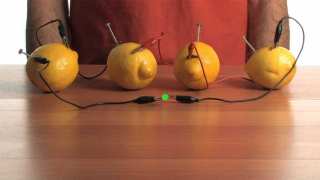The fad of wearable devices has brought us lots of exciting new technology, from the Fitbit to Apple Watch. It’s great to be able to sport your favorite electronic toy on your wrist as a fashion statement. But the potential for these devices could be much greater if they were able to harvest the energy from human motion—walking, finger tapping, even breathing—and use it as their power source. Imagine being able to measure your heart rate or body temperature with a single flick of the wrist, or power your smart watch with your shoe!
A power generator developed by researchers at Georgia Institute of Technology might be the key to making this technology possible. The new system, described in the journal Nature Communications, can efficiently convert the energy generated by a gentle tap of your palm into continuous direct-current electricity, which is compatible with modern electronic devices. What’s more, the whole device is about the size of your smartphone and five times lighter. It can hold up under long-term use and works fine in high humidity and rain. Embedded in the insole of your shoe or sewn into your jacket, this body-motion power generator could create an essentially infinite source of energy for your wearable devices—as long as you keep moving, it keeps going.
Unlike other traditional energy converters which tend to be large, heavy, and rigid, the new power system is made from a flexible polymer film which is layered with aluminum foil and copper to provide the electrical conductivity. When the device is tapped by a human palm, the surfaces of the hand and the device stick together briefly and a small amount of electric current is transferred between them. Since the energy provided from hand tapping is intermittent—sometimes you’re tapping and sometimes you’re not—the generator directs this electric current to a power management circuit that converts it into direct current, and then stores the energy for use in an electronic device.
What’s wrong with using mobile batteries in wearable electronics? It turns out that batteries are the largest and heaviest component of today’s electronic gadgets. Designers of every new device have to make a choice about how big the battery should be. The bigger the battery, the longer it will last before needing to charge, but that also makes it more cumbersome. On the other hand, very small and light batteries run out of power quickly, which is also majorly inconvenient. These factors are even more important for wearable devices: none of us wants a wearable pedometer that weighs us down while running, or that we have to stop and recharge every mile.
After showing that the system works and can convert up to 60% of the energy from hand tapping to electricity, the researchers used it in several example electronic devices that might be worn on the body. The generator provided continuous, consistent power for a temperature sensor simply by patting the device gently about once every two seconds. It also can be connected to a watch with a built-in scientific calculator. In their test, the calculator could do complex math operations including exponents and logarithms, and the watch kept on ticking even when the source of energy via hand tapping was irregular and random. Even an electrocardiography machine, which measures your heart’s electrical activity and which doctors use to check for heart disease, can be powered by this tiny generator.
There could be millions of applications for this kind of technology, and we’ll likely be seeing some of them when this new system, still just a proof of concept, can be incorporated into commercial electronics. Obviously, the possibility of medical diagnostic devices that you can wear on your body 24 hours a day could revolutionize the world of health care. But it could also make it easier for relatively healthy people to monitor their own fitness level, and to do simple tasks such as calculating a tip quickly and easily. Plus, with the advent of sustainable electricity from body motion, society can cut down on generating electric power from unsustainable fossil fuel sources. So get out and move your body—not only will it make you look good and feel good, but soon you can help save the world doing it!
Top image: Runner in Chicago (CC BY-SA 3.0)
Resources
S. Niu, X. Wang, F. Yi, Y.S. Zhou, Z.L. Wang. A universal self-charging system driven by random biomechanical energy for sustainable operation of mobile electronics. Nature Communications, 6:8975 (2015).
“Kapton® HN general-purpose polyimide film.” DuPont, http://www.dupont.com/products-and-services/membranes-films/polyimide-films/brands/kapton-polyimide-film/products/kapton-hn.html (accessed Nov. 30 2016).
Z.L. Wang. Triboelectric nanogenerators as new energy technology and self-powered sensors – Principles, problems and perspectives. Faraday Discussions (2015).







No comment